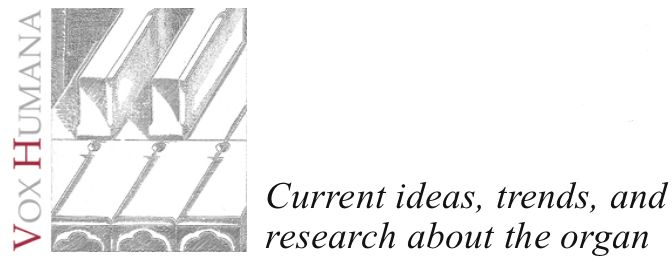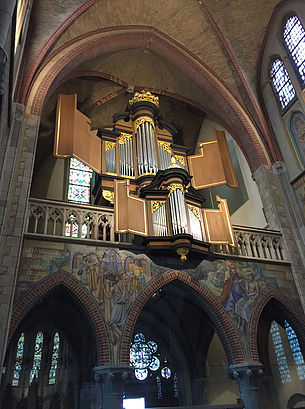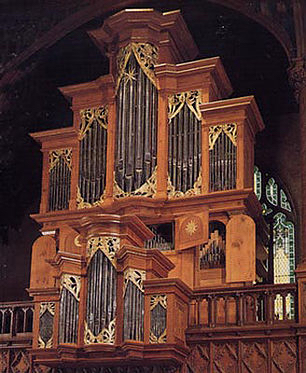


April 22, 2018
PAUL TEGELS
–––––––––––––––––––––––––––
Four Hand Organ Repertoire

April 22, 2018
PAUL TEGELS
–––––––––––––––––––––––––––
Four Hand Organ Repertoire

The 1998 Paul Fritts & Co. organ in Tacoma, Washington, at Pacific Lutheran University's Lagerquist Hall.
The 1998 Paul Fritts & Co. organ in Tacoma, Washington, at Pacific Lutheran University's Lagerquist Hall.
Introduction
In this interview, notable Dutch organist Paul Tegels, University Organist at Pacific Lutheran University, discusses his extensive work transcribing and arranging organ literature for four hands, and organ music and education in the Netherlands and the United States with Vox Humana Editor Christopher Holman.
––––––––––––––––––––––––
Professor Tegels, thank you for agreeing to this interview. To begin, could you tell us about your musical training? Did you study piano from an early age? When did you take up the organ, and what attracted you to it?
I really didn’t have much in the way of keyboard or piano skills before I started playing the organ. I grew up in a very small town (500 people at the time), and one day the church organist got sick. I had maybe a year of piano lessons, and I was the only one in the town who played any kind of keyboard instrument, so I had to substitute. I hate to think what it sounded like, but afterward I thought, “this is cool,” and I started taking lessons and stuck with it for several years. Then in my second year of high school, there was so much going on that organ was too much of a distraction, so I quit. However, my last year of high school I wanted to play organ again and took lessons; I got a church job, but I still wasn’t convinced that I was going to go into music. It was between mathematics and music for me, and ultimately music won, but it wasn’t really that firm a decision at the time — during my entrance exam at the conservatory, I thought, “well, if this doesn’t work, I can just go back to math.” But I got in.
Yet even at the conservatory, I had a motivational crisis in my third year, and I thought I might find some of life’s big questions studying philosophy. Well, it turns out that I didn’t find all the answers in philosophy, so I went back to playing organ and really enjoyed it. I went through six years of conservatory, and then faced the age old question: what do I do now?
If I’d stayed in the Netherlands, I probably could have gotten a job teaching organ lessons to adults at a music school, but I honestly really wanted to go somewhere else! And one day I saw a flyer in the hall for the Netherlands-America Commission for Educational Exchange, and I won a Fulbright to study at New England Conservatory. The Fulbright funded one year in the Master’s program, and after that, it seemed to make sense to finish the degree. I then stayed for another two years for an Artist Diploma. With the same visa, I could also do a year of practical training, which is when I took the job at Southern College (now Southern University) in Collegedale with the (at the time, new) John Brombaugh organ that had just been installed the previous spring. Again, I was going to stay for one year, and ended up staying two. But then I really had to return to the Netherlands, this time for a mandatory two years. I took a church job while Dana [Robinson, my partner,] studied with Harald Vogel on a Frank Huntington Beebe Fund grant. After that, I went then to Iowa State University for a doctorate, where I stayed for seven years. Afterward I got the job at Bethany College, and after that at Pacific Lutheran University, where I’ve been since.
In the Netherlands, there are many organs by some of the most important, influential builders in history. How did those instruments shape you as a musician growing up, and are there any instruments that are less well-known to American organists that we should take note of?

When people think of organs and cities in the Netherlands, they think mostly the west and north — Groningen, then along the northern coast, Amsterdam, Delft, and so on. That’s the most famous organ area, with the Schnitgers, the Müller at Haarlem, the Hagerbeer at Leiden, etc. But I think there are some interesting organs in the south and east as well. My education was in Arnhem, and there are some interesting instruments because of the influence from the French-speaking part of Belgium. One such organ that comes to mind is the Severijn organ in Cuijk, which is basically a French classical organ built between 1625 and 1650.

While I was a student in Arnhem, we took several organ tours around Europe (French Classical organs, Cavaille-Coll organs, northern Germany, and of course in the Netherlands), but the best was to East Germany to see the Silbermanns. At the time, I didn’t think much of it because I knew little about organ history; mainly, I recall thinking, “oh, nice organs…” and “wow, three manuals!” So I had a lot of catching up to do on organ history and instruments. In that sense, I don’t think that I was actually “ahead” of anyone in the U.S. with regard to historical organs.
Were there any organs in the United States that inspired you during your student years?

The modern state of building in the United States has been eye-opening for many people from all over the world. When I came in 1982, nobody in Europe knew any new American organs that were part of the historically-informed revival. Organs by Charles Fisk, John Brombaugh, and others that built in that style were absolutely eye-opening to me. I played some programs on the famous meantone organ at Wellesley college, and was absolutely amazed. At New England Conservatory, the Fisk at Old West Church was the main teaching instrument — it has a quality that is eclectic yet characteristic of historical organs.

I suspect many organists know fairly little Dutch organ music beyond that of Sweelinck. Have you come across any organ literature from the Netherlands that we should know about?
For old music, there are the psalms of Anthoni van Noordt, but otherwise, nothing terribly significant. There’s a lot of contemporary Dutch organ music by Hendrik Andriessen (1892–1981), and his sons were composers, but I don’t find the music all that interesting. I do like the music of Bert Matter; he started improvising in a minimalist style and then began writing it down. His Fantasie sopra “Von Gott will ich nicht lassen” is one of his best. A classmate of mine, Andries van Rossem, wrote a [presently unpublished] piece for the Nederlands Gregoriaans Festival called Oneliner (2014) for meantone organ that looked interesting, but technically very difficult.
In addition to an active performing career, you are University Organist at Pacific Lutheran University (PLU). What does such a position entail, beyond teaching?
PLU is an undergraduate liberal arts college with a professional music school, so anyone on the faculty primarily focuses on his/her specialty, and then teaches classes (for instance, I teach ear training and a semester of music history). As organ and harpsichord teacher, I’m by default the “early music person,” and I also direct the baroque ensemble called the “early music lab,” which is a required course for performance majors. I also direct the chapel choir. I’m also university organist, so I play for chapel services once per week, and for university events that require organ (the homecoming service, special occasions), and of course the big Christmas concert to basically a sold-out hall. And of course, there’s the organ series, so I have to be the sort of curator of the organ.
Given that PLU is part of the Evangelical Lutheran Church in America, are most of your students hoping to be professional church musicians, or will they primarily pursue careers teaching and performing?
It sort of depends. PLU is more affiliated by philosophy, rather than actually being strictly united with ELCA teachings, and the Pacific Northwest is one of the most "unchurched" areas of the U.S. Thus, the makeup of organ students is actually similar to most normal schools, so there’s a great deal of variety. We’re also only an undergraduate program, so majors normally have gone on to various graduate programs, and from what I’ve seen they don’t usually play for only one religious affiliation.
American aesthetics regarding hymn playing are highly controversial. I recall hearing you play hymns quite a bit differently than many of our colleagues. What is your philosophy regarding hymn playing, and how do you teach hymn playing to your students?
When I think of hymn playing, the term that comes to mind is “supportive leadership.” Meaning yes, you lead a hymn and congregation, but it has to be supportive and help them along. It shouldn’t take away from what the people are there to do: to be inspired (whether that’s musically, spiritually, or otherwise). In an introduction, I always say there are three things which should be clear: pitch/key, tempo, and character (i.e. O Sacred Head, Surrounded should be different than Praise to the Lord, the Almighty). Anything additional is nice, but it shouldn’t be distracting or confusing.
One big problem I notice, especially when the focus is completely on hymns such as in a hymn festival or a concert, sometimes the introduction can be so complicated that nobody knows when to start singing. When playing the hymn itself, it’s important that the organist breathes with the congregation, and the best way to do that is to make sure you’ve sung the hymn before (and remember it’s amateurs singing — not a professional choir). Some people follow the text’s punctuation completely literally, but I think it’s important to be more practical than anything else, even if a breath breaks up a sentence or musical thought.
What are your observations about the differences between organ education in the Netherlands and organ education in America, and what do you perceive to be the strengths and weaknesses of the different systems?
Professional music study in the Netherlands is based on the conservatory system, where you focus only on music. The strength in the U.S. is that, in most universities, music is so integrated into the life of the entire school, that you can pick and choose whatever you want to study. In a place like PLU, the majority of my students are majoring in something other than music, but can still receive some professional training as an organist — that’s just not possible in the Dutch system.
One plus of the Netherlands, though, is that students have access to all the historic organs (on a regular basis, or the occasional visit), and you grow up in an environment that is much more historically rich. You can’t beat that. I think it’s important for organists to at least experience the history of the instrument and the history of the environment.
I absolutely encourage American students to visit historical organs. In the U.S., I get a little wary about simply importing or copying historical organs and thinking, “that’s it, we don’t need to go to Europe.” It’s a whole different setting studying the organ in Europe —imagine a church on stone streets, with a local bakery nearby, people speaking in local dialects, etc. — these things are and have been intrinsically linked for hundreds of years.
If I had to choose between the systems, I still think I would choose to study in the U.S. because there is access to many other courses that can enrich one’s educational experiences. Most American degrees also require a minor in another field, and your thesis (or major degree project) is a combination of those two areas, and I think the current research climate is incredibly important.
One of your publication projects now is preparing organ transcriptions and arrangements for four hands, a genre which is certainly underrepresented. How did you become involved in this project, what sorts of pieces are you working on, and what is your process of arranging for four hands?
Well, if your partner is an organist and you want to do music together, then four hand organ music is a good idea! Dana [Robinson] and I started it as something for fun by playing Mozart's Fantasia in F Minor, K. 608 in a pretty literal transcription, and then I started expanding the repertoire. We found a Johann Christian Bach duetto (again, mostly just straight transcription), then we played the Mozart Variations in G Major, K. 501 from the four-hand piano score. Thus, my “arrangement” of that piece is really just a transcription but with some registration indications to make it more organ friendly.
One major consideration is the limited range of the organ keyboard, which requires some compromises. One example is the Schumann 6 Studien in kanonischer Form, Op. 56 for pedal piano; for each one, I basically pulled out the canons and made everything else accompaniment. However, there were still some places where I had to make some decisions, like where the canon dropped out.
There’s also the Mendelssohn Reformation Symphony, Op. 107, which is a completely different piece. I think the transcription works, but it’s definitely a transcription, in terms of making many decisions — primarily, where to put various melodies. When I started it, I had the full score, but also an old piano four hand arrangement.
Johann Christian Bach: Duetto in F Major, W.A. 19, transcribed by Paul Tegels, performed by Dana Robinson and Paul Tegels on the 1987 organ by Paul Fritts & Co. in Seattle, Washington, at Gethsemane Lutheran Church.
Ultimately, I ended up working from the full score because the piano arrangement was so limited, and there were so many things left out, too many octaves were changed. One danger of making a literal transcription of a piece like that is that it’s going to sound way too thick. I ended up making a lot of choices regarding what’s essential and what’s covered by other voices, and much of the process involved trying things out many times.

In the four hand repertoire, I don’t like very complicated pedal parts because they’re often an obstacle for playing a transcription well. Whenever there is some virtuosic low part, I try to keep it in the low hand of the second player, and if necessary, put it in octaves (originally those lines were played by cellos and double basses, so they were in octaves too). In terms of registrations in these more orchestral-style transcriptions, there are no registrations at all — it’s really up to the performer, and the performer should have listened to the original piece. In the end, the work ultimately does have to become an organ piece in the end. And mostly I had the organs that I had access to in mind (mainly the Paul Fritts and Co. organ at PLU).

––––––––––––––––––––––––
He received his Doctor of Musical Arts Degree in Organ Performance and Pedagogy and his Master of Arts Degree in Choral Conducting from the University of Iowa, where he studied organ with Delores Bruch, and choral conducting with William Hatcher. Other degrees and awards include the Artist Diploma and the Master of Music Degree in organ performance from the New England Conservatory in Boston where he studied with Yuko Hayashi and William Porter. He is the recipient of a Fulbright Scholarship from the Netherlands-America Commission for Educational Exchange.
He holds the teaching and performance degrees from the Stedelijk Conservatorium in Arnhem, The Netherlands, where he studied organ with Bert Matter and harpsichord with Cees Rosenhart. He has done extensive research on the organ and harpsichord concertos of Franz Joseph Haydn, and has played the first American performance of the Haydn Organ Concerto in D Major, Hob. XVIII-2, of which he has prepared a performance edition. Currently he is working on a publication of four-hand organ works/arrangements.
He is past dean of the Tacoma Chapter of the American Guild of Organists, and is past president of the Westfield Center for Keyboard Studies. Prior to his appointment at PLU, he taught at Bethany College in Lindsborg, KS.
The views and opinions expressed in this article are those of the author, and do not necessarily reflect the position of Vox Humana.